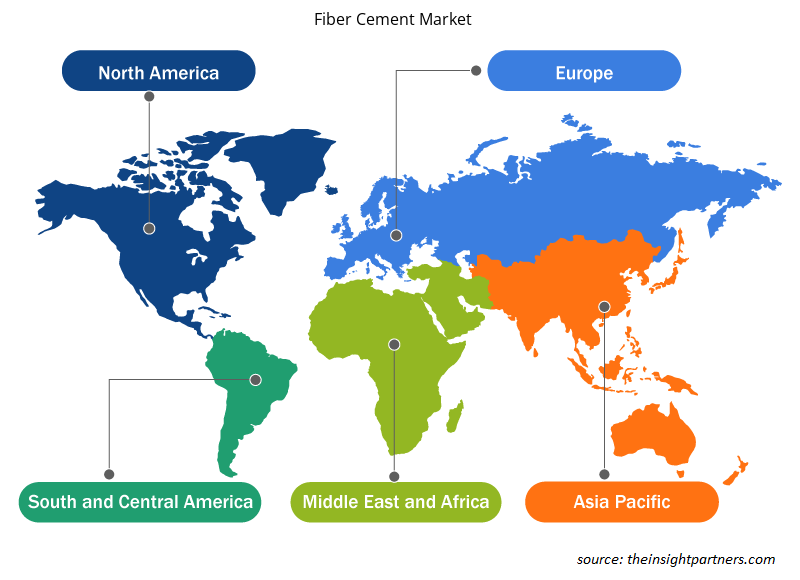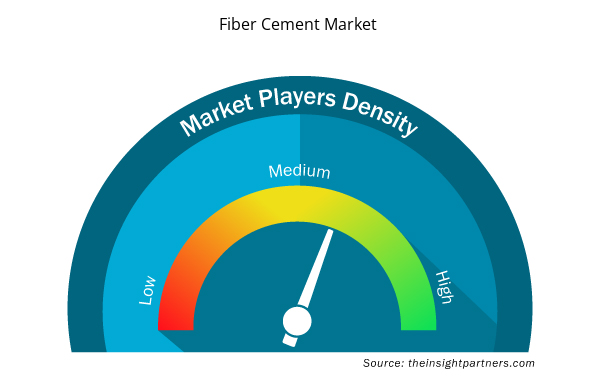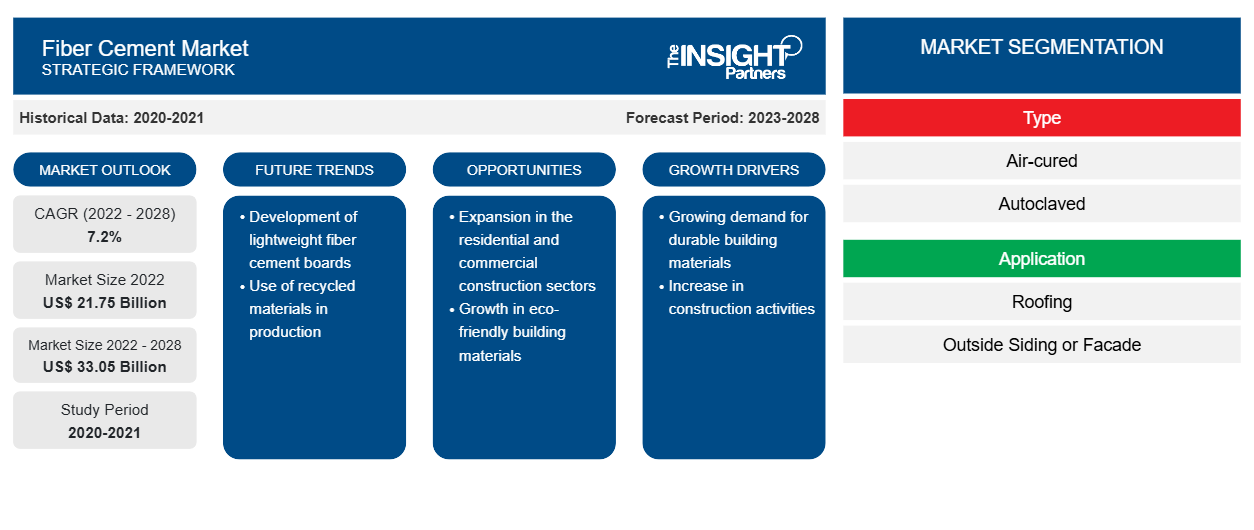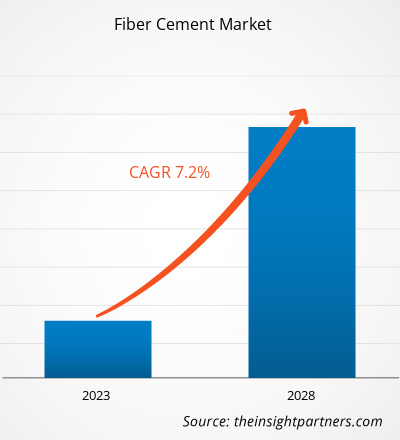[調査レポート] ファイバーセメント市場規模は、2022年の217億4,845万米ドルから2028年には330億5,223万米ドルに成長すると予想されており、2022年から2028年にかけて7.2%のCAGRを記録すると予測されています。
ファイバーセメントは、優れた耐久性と耐候性、耐火性を備えているため、外装サイディング材としてよく使用されています。また、ファイバーセメントは、大雨、雹、強風などの厳しい気象条件に耐えられるため、屋根材としてもよく使用されています。さらに、ファイバーセメントは成形が容易で、建物の外観に合わせて塗装または着色できるため、トリムや鼻隠しの作業にも使用できます。また、病院、学校、オフィスビルなどの商業ビルでも、メンテナンスが少なくて済むため、外観に耐久性のある選択肢となるため、頻繁に使用されています。
2022年、アジア太平洋地域は世界の繊維セメント市場で最大の収益シェアを占めました。アジア太平洋地域では、繊維セメントの利点に関する認識が高まっているため、繊維セメントの需要が増加しています。この地域は、建設活動の急増により、繊維セメントボードの利用における主要な市場の1つとして注目されています。さらに、メイク・イン・インディアなどの政府の取り組みや政策は、インドでのさまざまな製造工場の設立を奨励しています。外国直接投資の増加も、この地域の経済成長につながります。多くの住宅および非住宅部門での繊維セメントボードの使用数の増加により、今後数年間でアジア太平洋地域での繊維セメントボードの需要が増加すると予想されます。インドでは、建設業界は農業に次ぐ第2位の産業であり、国のGDPの約11%を占めています。建築・建設業界は、市場の成長に大きく貢献しています。
要件に合わせてレポートをカスタマイズする
このレポートの一部、国レベルの分析、Excelデータパックなど、あらゆるレポートを無料でカスタマイズできます。また、スタートアップや大学向けのお得なオファーや割引もご利用いただけます。
- このレポートの主要な市場動向を入手してください。この無料サンプルには、市場動向から見積もりや予測に至るまでのデータ分析が含まれます。
COVID-19パンデミックがファイバーセメント市場に与える影響
建設部門は、ファイバーセメントの需要に大きく貢献してきました。COVID-19パンデミックは、化学および材料部門とファイバーセメント市場の成長に悪影響を及ぼしました。SARS-CoV-2の拡散防止策の実施は、さまざまな業界の成長に悪影響を及ぼしました。包装、消費財、自動車および輸送、繊維、建築および建設などの業界は、国境と国境の突然の閉鎖による業務効率とバリューチェーンの混乱により悪影響を受けました。COVID-19パンデミックの間、収益の減少とプロジェクトデリバリーの課題の増加により、ほとんどの市場でセクターが縮小し、労働力に悪影響を及ぼしました。多くの工場が長期間にわたって閉鎖されたため、建設業者は輸入原材料とオフサイト建築資材の遅延とコスト増加を経験しました。建築および建設業界へのダメージは、パンデミック中のファイバーセメントの需要を妨げました。
市場分析
エネルギー効率の高い建物への需要の高まりが繊維セメント市場の成長を後押し
エネルギー部門管理支援プログラムによると、世界のエネルギーの約 3 分の 1 は、住宅、公共および商業ビルで、空間の冷房、暖房、換気、調理、冷蔵、照明、給湯、電気および機械装置の操作のために消費されています。発展途上国の都市の近代化と 1 人当たりの所得の増加により、世界中の建物でのエネルギー使用が促進されています。公共、住宅、商業ビルでのエネルギー消費量が多いため、エネルギー節約の必要性が生じています。国際エネルギー機関によると、2035 年までに建物は世界のエネルギー節約の可能性の約 41% を占めると予想されており、産業部門と輸送部門はそれぞれ 24% と 21% を占めることになります。繊維セメントの層を建物に塗布すると、壁を通じた熱伝導が減少し、冬は室内を暖かく、夏は涼しく保つことができ、エネルギー消費の削減に役立ちます。ASHRAE 基礎ハンドブックによると、繊維セメントの R 値は 0.15 で、レンガや石よりも優れています。
タイプインサイト
タイプに基づいて、世界の繊維セメント市場は、空気硬化型とオートクレーブ型に分かれています。オートクレーブセグメントは、2022年に大きな市場シェアを占めました。オートクレーブファイバーセメントは、セメント、砂、セルロース繊維、その他の添加剤の混合物から作られています。混合物をシートまたはボードに成形し、次にオートクレーブで硬化させます。オートクレーブは、材料に熱と蒸気を加える高圧容器です。オートクレーブ処理により化学反応が起こり、材料が強化され、耐久性が高まり、水、火、害虫に対する耐性が高まります。一般的に、屋根、サイディング、床、 セラミックタイルの裏地など、幅広い用途に使用されます。さらに、オートクレーブファイバーセメントは、木材や石などの他の建築材料の外観を模倣できるため、汎用性とデザインの柔軟性でも知られています。さまざまな色と質感で利用できるため、住宅と商業の両方の建設プロジェクトで人気があります。
James Hardie Industries plc、Etex NV、Swisspearl Group AG、CSR Ltd、NICHIHA Corp、Plycem Construsistemas Costa Rica SA、Compagnie de Saint Gobain SA、Century Plyboards Ltd、Everest Industries Ltd、および Isam Khairi Kabbani Group は、世界の繊維セメント市場で活動している主要企業です。市場プレーヤーは、顧客の需要を満たすために高品質の製品を提供することに重点を置いています。また、研究開発活動への投資や新製品の発売などの戦略も採用しています。
レポートの注目点
- 繊維セメント市場における進歩的な業界動向は、プレーヤーが効果的な長期戦略を策定するのに役立ちます。
- 先進国市場と発展途上国市場で採用されているビジネス成長戦略
- 2020年から2028年までのファイバーセメント市場の定量分析
- ファイバーセメントの世界需要の推定
- 業界で活動するバイヤーとサプライヤーの有効性を示すポーターの5つの力の分析
- 競争市場の状況を理解するための最近の動向
- 市場動向と見通し、およびファイバーセメント市場の成長を牽引・抑制する要因
- 商業的利益の基盤となる市場戦略を強調し、市場の成長につながる意思決定プロセスを支援する
- さまざまなノードにおけるファイバーセメント市場規模
- 市場の詳細な概要とセグメンテーション、およびファイバーセメント業界の動向
- 有望な成長機会のあるさまざまな地域の繊維セメント市場規模
ファイバーセメント市場の地域別分析
予測期間を通じてファイバーセメント市場に影響を与える地域的な傾向と要因は、Insight Partners のアナリストによって徹底的に説明されています。このセクションでは、北米、ヨーロッパ、アジア太平洋、中東、アフリカ、南米、中米にわたるファイバーセメント市場のセグメントと地理についても説明します。

- ファイバーセメント市場の地域別データを入手
ファイバーセメント市場レポートの範囲
| レポート属性 | 詳細 |
|---|---|
| 2022年の市場規模 | 217.5億米ドル |
| 2028年までの市場規模 | 330.5億米ドル |
| 世界のCAGR(2022年 - 2028年) | 7.2% |
| 履歴データ | 2020-2021 |
| 予測期間 | 2023-2028 |
| 対象セグメント | タイプ別
|
| 対象地域と国 | 北米
|
| 市場リーダーと主要企業プロフィール |
|
市場プレーヤーの密度:ビジネスダイナミクスへの影響を理解する
ファイバーセメント市場は、消費者の嗜好の変化、技術の進歩、製品の利点に対する認識の高まりなどの要因により、エンドユーザーの需要が高まり、急速に成長しています。需要が高まるにつれて、企業は提供を拡大し、消費者のニーズを満たすために革新し、新たなトレンドを活用し、市場の成長をさらに促進しています。
市場プレーヤー密度とは、特定の市場または業界内で活動している企業または会社の分布を指します。これは、特定の市場スペースに、その規模または総市場価値と比較して、どれだけの競合相手 (市場プレーヤー) が存在するかを示します。
ファイバーセメント市場で事業を展開している主要企業は次のとおりです。
- ジェームス・ハーディ・インダストリーズ
- エテックスNV
- スイスパールグループAG
- CSR株式会社
- ニチハ株式会社
免責事項:上記の企業は、特定の順序でランク付けされていません。

- ファイバーセメント市場のトップキープレーヤーの概要を入手
世界のファイバーセメント市場
繊維の種類に基づいて、世界の繊維セメント市場は、種類、用途、および最終用途に基づいて分類されています。種類に基づいて、世界の繊維セメント市場は、空気硬化型とオートクレーブ型に分類されています。用途に基づいて、繊維セメント市場は、屋根材、外壁またはファサード、その他に分類されています。最終用途に基づいて、繊維セメント市場は、住宅用と非住宅用に分類されています。
企業プロフィール
- ジェームス・ハーディ・インダストリーズ
- エテックスNV
- スイスパールグループAG
- CSR株式会社
- ニチハ株式会社
- プリセム コンストラシテマス コスタリカ SA
- サンゴバン社
- センチュリープライボード株式会社
- エベレスト インダストリーズ
- イサム・カイリ・カバニ・グループ
- 過去2年間の分析、基準年、CAGRによる予測(7年間)
- PEST分析とSWOT分析
- 市場規模価値/数量 - 世界、地域、国
- 業界と競争環境
- Excel データセット



Report Coverage
Revenue forecast, Company Analysis, Industry landscape, Growth factors, and Trends

Segment Covered
This text is related
to segments covered.

Regional Scope
North America, Europe, Asia Pacific, Middle East & Africa, South & Central America

Country Scope
This text is related
to country scope.
よくある質問
Asia Pacific accounted for the largest share of the global fiber cement market. Asia Pacific is one of the most significant regions for the fiber cement market owing to surging demand for energy-efficient buildings.
Durability is one of the most desirable qualities of fiber cement. Fiber cement siding, boards, and panels typically outlast vinyl siding and other alternative products in lifespan. Within 10 to 15 years, vinyl siding can show signs of aging, whereas fiber cement siding can last up to 30 to 50 years or more. Further, in cement production, carbon dioxide is a byproduct. However, manufacturing vinyl siding containing polyvinyl chloride (PVC) produces more carbon dioxide than cement production. Hence, fiber cement siding is a greener alternative to vinyl siding. Fiber cement products do not require frequent repainting as it holds paint well. Also, they do not dent unlike steel siding. Fiber cement products stand stronger in moisture and leaks than gypsum boards. These products possess excellent moisture-absorbing and drying properties, making them resistant to weather changes.
Based on type, autoclaved segment held the largest revenue share owing to the its durability and resistance to water, fire, and pests.
Based on the application, roofing segment is projected to grow at the fastest CAGR over the forecast period. Fiber cement roofing sheets and tiles are popular for their durability, resistance to weathering, and low maintenance requirements. They are also available in a variety of colors and styles to suit multiple architectural requirements and design preferences.
According to the World Bank, across the world, a large proportion of the population lives in cities. In 2011, 52.0% lived in urban areas. Over the last ten years, owing to urbanization in developing economies in Asia and Oceania, the urbanization rate increased from 43.3% in 2011 to 50.0% in 2021. Africa has seen a 4.6% increase in the same period. Governments of various countries across the world focus on supporting and increasing construction activities. Saudi Arabia launched its Saudi Vision 2030 to diversify its economy, modernize its administration, and introduce bold reforms in many sectors. The country is targeting to increase the contribution of its construction sector to the overall GDP. Due to its Saudi Vision 2030, the country's construction market reports significant growth in residential and nonresidential segments and offers lucrative potential to fiber cement.
The major players operating in the global fiber cement market are James Hardie Industries plc, Etex NV, Swisspearl Group AG, CSR Ltd, NICHIHA Corp, Plycem Construsistemas Costa Rica SA, Compagnie de Saint Gobain SA, Century Plyboards Ltd, Everest Industries Ltd, and Isam Khairi Kabbani Group.
Trends and growth analysis reports related to Chemicals and Materials : READ MORE..
The List of Companies - Fiber Cement Market
- James Hardie Industries plc
- Etex NV
- Swisspearl Group AG
- CSR Ltd
- NICHIHA Corp
- Plycem Construsistemas Costa Rica SA
- Compagnie de Saint Gobain SA
- Century Plyboards Ltd
- Everest Industries Ltd
- Isam Khairi Kabbani Group
The Insight Partners performs research in 4 major stages: Data Collection & Secondary Research, Primary Research, Data Analysis and Data Triangulation & Final Review.
- Data Collection and Secondary Research:
As a market research and consulting firm operating from a decade, we have published and advised several client across the globe. First step for any study will start with an assessment of currently available data and insights from existing reports. Further, historical and current market information is collected from Investor Presentations, Annual Reports, SEC Filings, etc., and other information related to company’s performance and market positioning are gathered from Paid Databases (Factiva, Hoovers, and Reuters) and various other publications available in public domain.
Several associations trade associates, technical forums, institutes, societies and organization are accessed to gain technical as well as market related insights through their publications such as research papers, blogs and press releases related to the studies are referred to get cues about the market. Further, white papers, journals, magazines, and other news articles published in last 3 years are scrutinized and analyzed to understand the current market trends.
- Primary Research:
The primarily interview analysis comprise of data obtained from industry participants interview and answers to survey questions gathered by in-house primary team.
For primary research, interviews are conducted with industry experts/CEOs/Marketing Managers/VPs/Subject Matter Experts from both demand and supply side to get a 360-degree view of the market. The primary team conducts several interviews based on the complexity of the markets to understand the various market trends and dynamics which makes research more credible and precise.
A typical research interview fulfils the following functions:
- Provides first-hand information on the market size, market trends, growth trends, competitive landscape, and outlook
- Validates and strengthens in-house secondary research findings
- Develops the analysis team’s expertise and market understanding
Primary research involves email interactions and telephone interviews for each market, category, segment, and sub-segment across geographies. The participants who typically take part in such a process include, but are not limited to:
- Industry participants: VPs, business development managers, market intelligence managers and national sales managers
- Outside experts: Valuation experts, research analysts and key opinion leaders specializing in the electronics and semiconductor industry.
Below is the breakup of our primary respondents by company, designation, and region:

Once we receive the confirmation from primary research sources or primary respondents, we finalize the base year market estimation and forecast the data as per the macroeconomic and microeconomic factors assessed during data collection.
- Data Analysis:
Once data is validated through both secondary as well as primary respondents, we finalize the market estimations by hypothesis formulation and factor analysis at regional and country level.
- Macro-Economic Factor Analysis:
We analyse macroeconomic indicators such the gross domestic product (GDP), increase in the demand for goods and services across industries, technological advancement, regional economic growth, governmental policies, the influence of COVID-19, PEST analysis, and other aspects. This analysis aids in setting benchmarks for various nations/regions and approximating market splits. Additionally, the general trend of the aforementioned components aid in determining the market's development possibilities.
- Country Level Data:
Various factors that are especially aligned to the country are taken into account to determine the market size for a certain area and country, including the presence of vendors, such as headquarters and offices, the country's GDP, demand patterns, and industry growth. To comprehend the market dynamics for the nation, a number of growth variables, inhibitors, application areas, and current market trends are researched. The aforementioned elements aid in determining the country's overall market's growth potential.
- Company Profile:
The “Table of Contents” is formulated by listing and analyzing more than 25 - 30 companies operating in the market ecosystem across geographies. However, we profile only 10 companies as a standard practice in our syndicate reports. These 10 companies comprise leading, emerging, and regional players. Nonetheless, our analysis is not restricted to the 10 listed companies, we also analyze other companies present in the market to develop a holistic view and understand the prevailing trends. The “Company Profiles” section in the report covers key facts, business description, products & services, financial information, SWOT analysis, and key developments. The financial information presented is extracted from the annual reports and official documents of the publicly listed companies. Upon collecting the information for the sections of respective companies, we verify them via various primary sources and then compile the data in respective company profiles. The company level information helps us in deriving the base number as well as in forecasting the market size.
- Developing Base Number:
Aggregation of sales statistics (2020-2022) and macro-economic factor, and other secondary and primary research insights are utilized to arrive at base number and related market shares for 2022. The data gaps are identified in this step and relevant market data is analyzed, collected from paid primary interviews or databases. On finalizing the base year market size, forecasts are developed on the basis of macro-economic, industry and market growth factors and company level analysis.
- Data Triangulation and Final Review:
The market findings and base year market size calculations are validated from supply as well as demand side. Demand side validations are based on macro-economic factor analysis and benchmarks for respective regions and countries. In case of supply side validations, revenues of major companies are estimated (in case not available) based on industry benchmark, approximate number of employees, product portfolio, and primary interviews revenues are gathered. Further revenue from target product/service segment is assessed to avoid overshooting of market statistics. In case of heavy deviations between supply and demand side values, all thes steps are repeated to achieve synchronization.
We follow an iterative model, wherein we share our research findings with Subject Matter Experts (SME’s) and Key Opinion Leaders (KOLs) until consensus view of the market is not formulated – this model negates any drastic deviation in the opinions of experts. Only validated and universally acceptable research findings are quoted in our reports.
We have important check points that we use to validate our research findings – which we call – data triangulation, where we validate the information, we generate from secondary sources with primary interviews and then we re-validate with our internal data bases and Subject matter experts. This comprehensive model enables us to deliver high quality, reliable data in shortest possible time.


 このレポートの無料サンプルを入手する
このレポートの無料サンプルを入手する